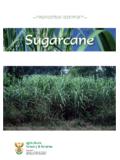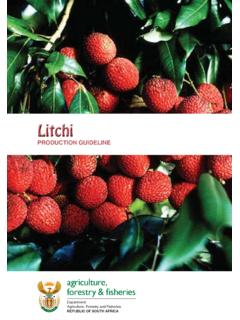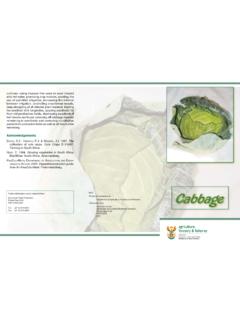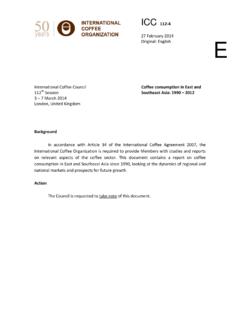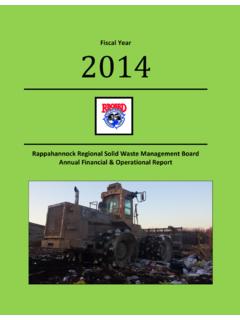Transcription of ILVKHULHV
1 DJULFXOWXUH IRUHVWU\ ILVKHULHV &GRCTVOGPV #ITKEWNVWTG (QTGUVT[ CPF (KUJGTKGU4'27$.+% 1( 5176* #(4+%#Cotton Production guidelineCottonProduction guideline2016 Design and layout byDirectorate Communication ServicesCompiled byDirectorate Plant ProductionPrivate Bag X144,Pretoria 0001 DISCLAIMERThe Directorate: Communication Services and its sub-directorates will not be held responsible for any documents that were brought for layout (Design and Publications Services Sub-directorate) without it having gone through for editing (Editorial Services Sub-directorate) this goes for all documents that are brought forward by the Directorate: Communication Services and it s sub-directorates for thorough analysis of the content(s) thereof as this will compromise the quality of the work.))))]
2 Therefore, the authors or compilers of the original document(s) within the department are responsible for making sure that the proper channels and procedures are followed in ensuring that the document receives the required 1: General aspect ..1 Part 2: Cultivation practices ..6 Part 3: Post-harvest handling ..17 Part 4: Production schedule ..18 Part 5: Utilisation ..19 Part 6: References ..191 PART I: GENERAL ASPECTS1. ClassificationScientific name: Gossypium hirsutumCommon names: Cotton (English), Katoen (Afrikaans), Ukotini (isiZulu),Katuni (Sepedi)2. Origin and distributionThe word cotton originated from the Arabic term al qutn, which became algod n in Spanish and cotton in English. Scientists searching caves in Mexico found piec-es of cotton bolls and parts of cotton cloth that proved to be at least 7 000 years old.
3 They also found that the cotton itself was much like that grown in America today. Cotton seeds are believed to have been planted in Florida in 1556 and in Virginia in 1607. By 1616, colonists were growing cotton along the James River in Virginia. In the Indus River valley in Pakistan, cotton was being grown, spun and woven into cloth 3 000 years BC. At about the same time, natives of Egypt s Nile valley were making and wearing cotton clothing. In South Africa cotton was planted in the Western Cape as early as 1690 and was reintroduced in 1846. It was planted on a large scale in the former Natal and the Cape colony from 1860 to 1870 owing to its high demand. A cotton gin was erected in the Tzaneen area, where cotton was ginned and baled mechanically.
4 The cooperative movement with regard to cotton had its origins in 1922 when a cooperative and ginnery were established at Barberton. By 1969 about 80% of the total crop was being produced in the irrigation areas of Loskop, Vaalharts and Production South THE INTERIORAs far as the local outlook is concerned, the first estimate for the 2014 /15 produc-tion year indicates a total crop of 98 925 lint bales, up 105% from the previous season mainly because of interventions implemented under the South African Clothing and Textile Cluster, which was established last year. About 95 325 lint bales are estimated to be produced from Republic of South Africa grown seed cot-ton, up 118% from the previous season.
5 The balance of 3 600 lint bales relates to the expected Swaziland produced crop to be ginned by the Swaziland gin (Cotton SA, 2015).Cotton production in South Africa has been declining owing to competition from other countries where government support programmes sustain the local farming community, and the relative returns that can be made from competing crops such as maize and sunflower in the South African markets. Several Southern African Development Community countries are producers and with the abolition of import duties, this cotton is being used in South African mills. The wide-scale introduction of Genetically Modified (GM) cotton varieties by both commercial and developing farmers has contributed significantly to improving the yields and profitability of cot-ton, but has failed to induce expansion of planted InternationallyRising world cotton stocks outside China and reduced imports are continuing to place downward pressure on international cotton prices.
6 The latest indicator of international cotton prices of about 66 US c/lbs is reported to be down by 33% 3compared to the peak of eight months ago. Similarly, cotton futures are down to the levels that were last seen seven years ago. However, the 2014 /15 season is reported to be the fifth consecutive season in which cotton production will ex-ceed consumption. Because of lower average world cotton yields the International Cotton Advisory Committee (ICAC) forecasts world cotton production to remain stable at 26,2 million tons in 2014 /15 despite a 3% increase in global numbers of hectares. Cotton-production of the world s four largest cotton producing countries (China, India, USA and Pakistan) is, however, expected to increase by 3% in 2014 /15.
7 In contrast, the ICAC expects cotton production to decrease by 18% in the Southern Hemisphere in 2014 /15. In Brazil and Australia, the Southern Hemi-sphere s largest cotton-producing countries, production is forecast by the ICAC to decline by 13% and 35% respectively, mainly owing to high production costs in Brazil and the drought and insufficient irrigation water in Australia. After declining by 1% in 2013/14, world cotton consumption is expected to recover by 3,8% to 24,4 million tons in 2014 /15. The world cotton trade is forecast by the ICAC to de-crease by nearly 1 million tons in 2014 /15, the third consecutive season in which imports have dropped. This is mainly owing to the decline in China s imports from over 5,3 million tons in 2011/12 to less than 2 million tons in 2014 /15.
8 In the SADC region cotton is produced in countries such as Namibia, Swaziland, Botswana, Malawi, Angola, Mozambique, Tanzania, Democratic Republic of Congo (DRC), Zambia and Major production areas in South AfricaTraditional cotton production areas in South Africa are as follows: Limpopo Prov-ince in Loskop, North and South flats from Bela-Bela to Mokopane, Dwaalboom, Thabazimbi and Weipe, North West Province covering the areas of Taung, Stella, Delareyville and Mareetsane, KwaZulu-Natal on the Makhathini Flats, Mpumalan-ga and Northern Cape in the lower Orange River, Vaalharts, Douglas and Prieska districts. This situation has slightly changed over the years with the result that dur-ing 2010/11 in North West Province, cotton was only grown in Taung and Plant Mature plantA cotton plant has a single, ascending main stem that bears a leaf at each node and usually has one branch.
9 Vegetative branches (monopodia) tend to be pro-duced lower down on the plant, while reproductive branches (sympodia) are pro-duced higher up or on the monopodia (Figure ). The sympodia are generally short and terminate in a flower LeavesCotton leaves are large, palmately lobed (three, five or seven lobed) and covered with multicellular stellate FlowersPlants in the genus Gossypium have showy flowers, each with five sepals united into a cuplike calyx and five petals of whitish or yellowish colour that often turn pink with usually occurs in the early afternoon. By late afternoon the corolla be-gins to change colour, first becoming a faint pink and later a deep red-mauve. At the same time, the bracts (calyx) close round the ovary.
10 At this stage, the bud is termed a square. As the square develops, the fruit increases in size and protrudes beyond the 1: Morphology of the cotton plant (Bennett, 1991)a - squareb - burst bollc - sympodiumd - monopodiume - main stem5. CultivarsThere are various most commonly cultivated cotton cultivars in South Africa which includes: LS9219, NuOPAL, Delta Opal RR or SZ9314 and Delta OPAL Yield. These cultivars are preferred in terms of fibre length, fibre strength, micronaire value, fibre percentage, good adaptability and tolerance to Climatic TemperatureCotton is essentially a tropical crop. Favourable weather conditions for cotton pro-duction are when summer temperatures do not drop below 25 C.
